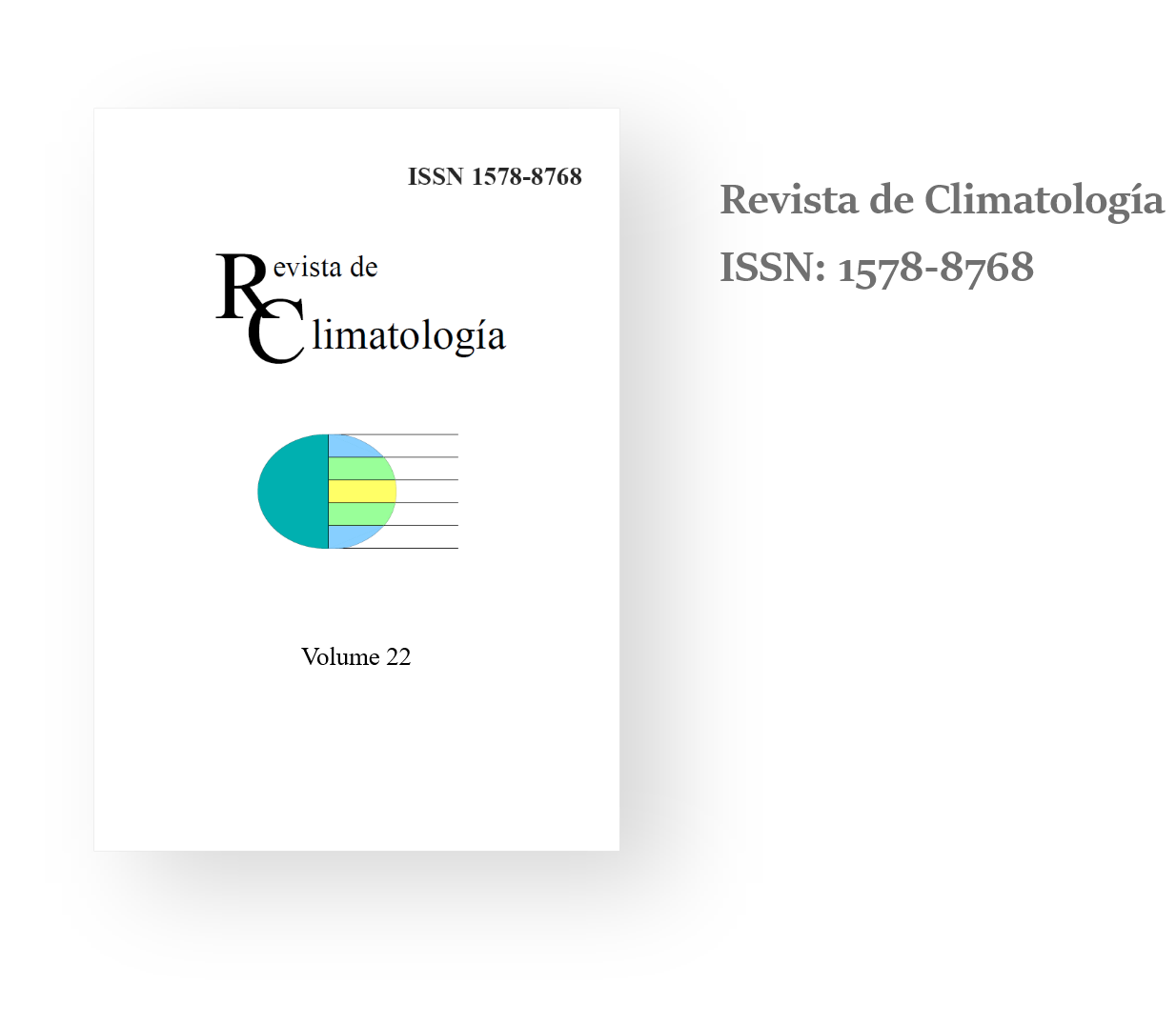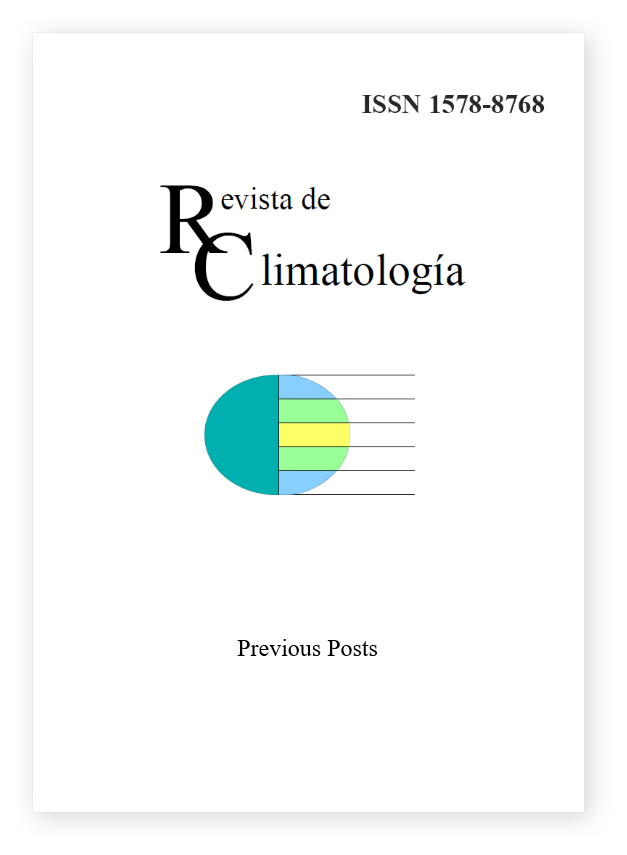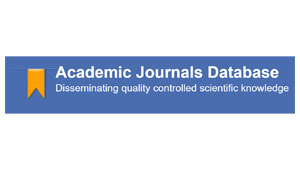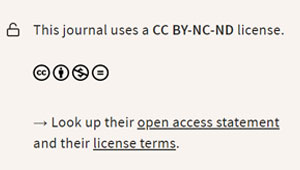
Volume 24 (2024)
Rainfall behavior and climate change in the Mayabeque basin, Cuba (1960 – 2020)
Adrián Álvarez Adán
DOI: 10.59427/rcli/2024/v24.103-109
The behavior of precipitation in the Mayabeque basin and its projections for the region are diagnosed according to the possible future climatic contexts expected for Cuba. For them, average monthly precipitation data were used from the period 1961 – 2020 from five meteorological stations of the Institute of Meteorology in the region under study. Its analysis was carried out through time series analysis. With the analysis of future contexts of climate change, precipitation anomalies in both scenarios (A2 and B2) are accentuated, with values between 13 and 22% respectively. This decrease is manifested in the annual and monthly water deficits as well as in the behavior by periods. It is concluded that the Mayabeque basin must begin to project adaptation measures to the effects of climate change.
Pág 103-109, 30 Dic
Recurrence of hurricanes as extreme weather events in Honduras
Alcides Iván Meza
DOI: 10.59427/rcli/2024/v24.88-102
From year 1893 to 2020, seven extreme weather events have been recorded in Honduras. The event count follows a Poisson distribution with a $\lambda$ value equal to 1. The arrival intervals follow a continuous Exponential distribution with mean equal to 1, equivalent to a 21.17-years period. The occurrence of hurricanes as extreme weather events is a random discrete statistical variable; the arrival intervals have a modal value of 20 years, a lowerbound of 20 years and an upperbound of 24 years. The cumulative occurrence probability exceeds the cumulative non-occurrence probability at the 15-year threshold. These extreme events are strongly associated with the Atlantic Multidecadal Oscillation (AMO) and El Niño Southern Oscillation (ENSO 3.4) indices. The average period of events’ occurrence coincides exactly with one-fourth the estimated extension range’s upper limit projecting the total AMO cycle, which is a range of 60-85 years. One extreme weather event coincides with a moderate El Niño, within a very prolonged period of predominantly neutral El Niño, as an exception; while for the remaining six events, all of them coincide with the onset or the intermediate period of a prolonged La Niña, just following after a predominantly moderate or strong El Niño.
Pág 88-102, 30 Dic
Statistical and Dynamic Characterization of Snow Precipitation for the 2023 Season in the Arid Andes and its Surroundings
Arnobio Germán Poblete, María José Vera, María Agustina Albeiro Castro
DOI: 10.59427/rcli/2024/v24.74-87
The societies of Cuyo and Central Chile are watching what happens to snowfall in the arid Andes as they suffer an increasingly acute and prolonged water deficit, which has been termed the ‘Megasequia’. These have been part of the continent’s history for centuries, essentially having a natural component, but climate change is amplifying their intensity, frequency and duration. Because of this, the 2023 snow season, like the previous year, was expected to be an index that would reflect the continuity or interruption of the Megasequence, which reinforces the need to investigate it in greater detail, as a result of the state of the atmospheric, oceanic and ocean-atmosphere coupling forcings that produced it.The purpose of this work is to describe statistically its snow sequence and the boundary conditions that gave rise to the behaviour of this season, its monthly variability and, in turn, to confirm whether it constituted an interruption, attenuation or continuity of the Megasequence.
Pág 74-87, 30 Dic
Characteristics of Cyclonic Disturbance on India and their Impact Analysis on Human and Economic Losses
Monu Yadav, Laxminarayan Das
DOI: 10.59427/rcli/2024/v24.64-73
This paper explores the features of cyclonic disturbances in the North Indian Ocean (NIO) by utilizing data from 1990 to 2022. It investigates the occurrence rate of these disturbances and their effects on human and economic losses throughout the mentioned period. The analysis demonstrates a rising trend in cyclonic disturbances in the NIO. While there has been a slight decline in cyclonic disturbance-related fatalities since 2015, there has been a considerable increase in economic losses. These findings can be attributed to enhanced government initiatives in disaster prevention and mitigation in recent years and rapid economic growth in regions prone to CDs. The study sheds light on the significance of addressing the impact of CDs on both human lives and economic stability in the NIO region.
Pág. 64-73, 06-Oct,
Validation and evaluation of global solar radiation by applying empirical models based on daily thermal amplitude 2014-2021
Lelia Quispe Huamán, Matías Huillca Arbieto, Vilma Sarmiento Mamani, Guina Sotomayor Alzamora
DOI: 10.59427/rcli/2024/v24.54-63
Measuring global solar radiation is a challenging task due to the difficulty in obtaining daily data, primarily due to technical and financial constraints. This has led to the development of empirical models for estimation. The objective of this research is to find the empirical model with the best performance using thermal amplitude for Puno. Three empirical models, namely Bristow-Campbell, Chen, and Hargreaves-Samani, were validated using measured data from the Puno meteorological station of the National Meteorology and Hydrology Service between 2014 and 2021. As a result, correlation coefficients of 0.922, 0.862, and 0.882 were obtained for Bristow-Campbell, Chen, and Hargreaves-Samani models, respectively. The percentage of the root mean square error was 6.494%, 8.278%, and 7.694% between measured and estimated values, respectively. The conclusion is that the Bristow-Campbell model fits better in the evaluated area. Thus, determining daily global solar radiation in the area will facilitate studies on climate change, solar energy applications, among other research areas. Finally, it is suggested that validated empirical models serve as predictors for designing applications by scientists, policymakers, and other stakeholders.
Pág. 54-63, 05-Oct,
Identifying the relationships of a network of local actors for disaster preparedness. Colombian case study
Lorena Giraldo Gómez, Diana María Cárdenas Aguirre, Juan Camilo López Vargas
DOI: 10.59427/rcli/2024/v24.44-53
This article seeks to identify the characteristics of the relationships of the network of actors involved in the preparedness stage of disaster management. The city of Manizales, Colombia, is taken as a case study. A characterization is made by applying the methodology of social network analysis to evaluate the relationships among the actors. The results obtained show that the network has established processes, where information is shared among all participants, has formal communication channels, and the entity representing the local government is the central and most relevant actor. The calculated indicators show that the network has 61% of the possible connections among the actors, where each actor has an average of 5.5 links with the other actors that constitute the network. Individually, it is highlighted that there are two actors that share information to 9 of the 10 actors in the network, and they are considered the most influential compared to two actors that only share relationships with 4 actors. This methodology has the potential to be replicated to other stages of humanitarian logistics, as well as in other regions with different characteristics.
Pág. 44-53, 08-Ago,
Responses of precipitation in Venezuela to the current unprecedented warming of global ocean waters
Dirk R. Thielen, Mary L. Puche, Paolo Ramoni Perazzi, José I. Quintero, Guillermo Bianchi, Ezequiel Zamora Ledezma, Alberto Quintero, Marco Marquez, Wilmer Rojas
DOI: 10.59427/rcli/2024/v24.22-43
This is the first study that addresses the problem generated by the current occurrence of unprecedented widespread ocean warming, at a speed and intensity not foreseen in any of the pre-existing models, with proven capacity to affect, significantly and within a few months, precipitations in much of the territory of Venezuela and the region. Relative to this problem, the research provides information on the following core aspects: 1- The evolution and dynamics of extreme climate events in Venezuela, 2- Their origin and determining factors, and 3- Reliable forecasts based on identified determinants and current trends. The results indicate that more than 25% of precipitation in Venezuela is associated with the occurrence of extreme events. Where, sea surface water warming of the Caribbean and the tropical North Atlantic have generated the main and most intense historical humid pulses. As for the main droughts, these are better explained by the occurrence of “Niño Atlántico” events, instead of global El Niño (the warm phase of ENSO). Until the current widespread oceanic warming is reversed, in Venezuela, the spatially and temporally extensive pulses of extreme drought, generated mainly by a quasi-permanent Atlantic Niño condition, will be recurrent climatic phenomena that will alternate with those extreme humid pulses, generated by the simultaneous warming of the waters of the Caribbean Sea and the tropical North Atlantic. The humid pulses, although extreme, would in turn be brief, linked to an exacerbation of yearly cyclonic activity resulting from the persistence of warm waters in this section of the Atlantic basin.
Pág. 22-43, 21-Jun,
Carbon dioxide detection for soil organic carbon quantification
Pedro Antonio Gonzales Sánchez, Bessy Castillo SantaMaría, Carlos Armando Ríos López, Guillermo Vásquez Ramírez, Enrique Arévalo Gardini, Jaime Walter Alvarado Ramírez
DOI: 10.59427/rcli/2024/v24.17-21
The telematic network system for detecting CO2 , for the quantification process of soil organic carbon in the San Martín Region; seeks to improve the quantification process of soil organic carbon through a telematic network system for CO2 detection. The methodology, a telematics network with Ethernet network architecture is designed and implemented, allowing the monitoring of the different parameters of the sensors, in the CO2 detection process and designing a CO2 capture chamber that, when put into operation, particle values were obtained. per million (ppm) of CO2 . Results, with the average information availability time being 838.33 seconds and an average area under the captured CO2 curve of 98,210 ppm2. Likewise, the control group was measured in the soil laboratory of the National University of San Martin, where the average quantification time was 126 hours, yielding an average percentage of soil organic carbon of 0.69; For the experimental group, produced by a telematic CO2 detection network system, the average quantification time is 0.32 hours, yielding an average percentage of soil organic carbon of 0.69. Therefore, it is concluded that the use of the networked CO2 detection system will improve the quantification process of soil organic carbon in the San Martín Region.
Pág. 17-21, 21-Jun,
Nitrogen dioxide and carbon monoxide levels after the COVID-19 pandemic in the province of Los Ríos, Ecuador
Roberto Johan Barragán Monrroy, Ana Madelaine Macias Mendoza, Betty Beatriz González Osorio
DOI: 10.59427/rcli/2024/v24.09-16
The objective of this research was to evaluate variations in tropospheric concentrations of nitrogen dioxide (NO2) and carbon monoxide (CO) in the cantons of Los Rios province, Ecuador, before (March 16 to December 31, 2019) and during (March 16 to December 31, 2020) the COVID-19 pandemic. Atmospheric data were obtained from the TROPOMI of the European Space Agency’s Copernicus Sentinel-5P satellite. It was observed that nitrogen dioxide (NO2) concentrations for 2019 were higher compared to 2020, evidencing a decrease of 8% during the pandemic. In contrast, carbon monoxide (CO) concentrations increased by 3% during the pandemic.
Pág. 09-16, 21-Jun,
Recurrence of Intense winds and precipitation in the Rio Negro Hydrographic lower Basin (Argentina)
Grethel García Bu Bucogen
DOI: 10.59427/rcli/2024/v24.01-08
The aim of the study is to analyze return periods and understand the occurrence of intense winds and precipitation in the Rio Negro hydrographic lower basin, in order to enhance the understanding of flood-related risks in the region. Precipitation and wind data were obtained from the NASA POWER project database and the Viedma Aero meteorological station of the National Meteorological Service. Return periods were calculated for both rainfall and intense winds using the Gumbel statistical distribution at a 95% confidence level. Results show predominant winds from the northwest, north, and north-northwest, with a more recurrent regime of moderate breeze. The analysis of Maximum Probable Precipitation (PMP) demonstrated that the highest rainfall occurs eastward of the basin, with a probability of daily precipitation exceeding 60 mm every two decades. Additionally, the occurrence of intense south winds is observed to potentially favor flood production approximately every 10 years. The findings of this research contribute to a better understanding of the risks associated with extreme rainfall and wind events, thereby facilitating the planning of mitigation and adaptation measures.
Pág. 01-08, 21-Jun,
Volume 23 (2023)
The Association between climate indexes and tropical cyclones in decadal rainfall in San Ramón, Costa Rica
Marvin E. Quesada
DOI: 10.59427/rcli/2023/v23.190-200
The decadal variability of precipitation over San Ramón, Costa Rica (SR-CR) and its relationship with the ONI, CLLJ, AMO indexes, and the frequency of tropical cyclones is investigated. Correlation tests are applied between the different indices with eight decades of precipitation in San Ramon. De-cadal precipitation shows that the driest were 1960-69 and 1980-89, and the wettest were 1970-79 and 1990-99. Every twenty years there is a climate change from wet to dry or dry to wet. During El Niño (ONI) events, the Pacific increases sea surface temperature (SST) and precipitation decreases in SR-CR and during La Niña, SST decreases and tends to rain more in SR-CR. Low values of the CLLJ tend to increase the incidence of precipitation in the area. Cyclonic activity has an appreciable influence on rainfall in SR-CR, the first two decades there were one and two cyclones. However, the rest of the decades showed more cyclones per decade, as is the case with 2010-19 with 8 cyclones. The relation-ship between the AMO index and precipitation in San Ramon has a 3-month lag.
Pág. 190-200, 27-Dec,
Relationship of the annual spill of the San Juan River with multivariate indices that estimate the behavior of the enso and the South Pacific anticyclone
Arnobio Germán Poblete, María Agustina Albeiro Castro
DOI: 10.59427/rcli/2023/v23.179-189
In search of more effective indices to explain the dynamic condition that influences snowfall in the Arid Andes, represented by the San Juan River spill (DJUA); in this work, two of them are analyzed, whose advantage is that they are multivariate, and, therefore, more representative of the climatic conditions prevailing in the April-September period. One of them is the Multivariate El Niño Southern Oscillation Index -ENSO- (MEI), which combines both oceanic and atmospheric variables, in a time series from 1979 to 2023. On the other hand, to measure the Western South Pacific Subtropical Anticyclone (ASPSO), of great magnitude and extension, the South Pacific Pressure Index (IPPS), developed and implemented by the Chilean Meteorological Directorate (DMC), is considered to be the most appropriate. From the analysis using specific statistical methodologies of these indices, it is concluded that both ratify the Megadrought prevailing in the Arid Andes since 2010, and in addition, show a trend that this could continue over time.
Pág. 179-189, 27-Dec,
Current and future edaphoclimatic conditions for establishment of the raft (Ochroma ssp.) with grasses in Eastern Ecuador
Carlos Alberto Nieto Cañarte, Macías Suárez Jordán Hernán, Víctor Manuel Guamán Sarango, Byron Andres Burgos Carpio
DOI: 10.59427/rcli/2023/v23.167-178
The general objective of the research was: Evaluate the climatically suitable areas in current and future conditions for the establishment of raft plantations in pastures as a silvopastoral initiative in the Ecuadorian Amazon. The research was carried out in the Ecuadorian Amazon, which is made up of six provinces: Sucumbíos, Orellana, Napo, Pastaza, Morona Santiago and Zamora Chinchipe. The research is descriptive and explanatory, using the analytical, deductive and synthetic method; A spatial modeling was carried out using GIS software of parameters such as temperature, precipitation, elevation and texture, to determine the most favorable areas for the establishment of the pond in grass, an agroecological zoning of the Ecuadorian Amazon was carried out. The results show that the majority of the provinces of the Ecuadorian Amazon are within the optimal edaphoclimatic parameters for the establishment of raft cultivation on grass; But the zoning showed that the province of Morona Santiago is the one with the largest territory with high suitability for this crop, being the province of Napo, which does not present high suitability and is only located in medium suitability. The proposal is aimed at soil conservation through the use of sustainable processes. It is concluded that the Amazon can host grass rafting within the indicated areas, but it must be carried out by trained professionals with knowledge on the subject.
Pág. 167-178, 26-Dec,
Agronomic behavior of the olive tree (Olea europaea L.) in relation to local temperatures in the southwest of Buenos Aires, Argentina
Goñi L, García R.J, Suñer L.
DOI: 10.59427/rcli/2023/v23.157-166
Low temperatures represent one of the main limitations for growing olive trees (Olea europaea L.) in many regions of Argentina. In the southwest of Buenos Aires province (SWB), olive oil production is presented as an alternative to the typical planting of winter cereals and livestock production. The aim of this work was: evaluate the timing of phenological stages in the SOB and their relationship to local temperatures. We calculated low temperature risk and frost probability at harvest time and after sprouting. During winter, there was frost risk temperature in Cabildo and Puan, but there was no risk for frost damage in Dorrego. Additionally, no temperature close to -12ºC was found in any location. Furthermore, the likelihood of frost damage to flower buds during sprouting period can affect oil production, mainly in Cabildo. The optimal harvest period with little risk of freezing temperature was earlier in Puan but more extended period in Dorrego. The results would indicate that the SOB region has good weather conditions for olive growing. However, risk will be mainly subject to primarily spring frost, during flower bud outgrowth. These results should be useful to carry out a more efficient management of agricultural practices in olive orchards. Further investigation is still needed to assess additional new information and encourage new investments.
Pág. 157-166, 26-Dec,
Detecting Tropical Cyclone from the basic overview of life cycle of Extremely Severe Cyclonic Storm, Tauktae
Monu Yadav, Laxminarayan Das
DOI: 10.59427/rcli/2023/v23.149-156
The Extremely Severe Cyclonic Storm (ESCS) Tauktae, which made landfall on the Gujarat coast on May 17, 2021, is discussed in the current study. The analysis is based on INSAT-3D and passive microwave (PMW) images, fo-cusing on the cyclone’s eye characteristics and intensity. The satellite imag-es and products are utilized to determine the cyclone’s intensity and the spe-cific characteristics of its eye. The study showcases the variations in intensi-ty and eye features of the cyclone throughout its life span, providing insights into the process of tropical cyclone intensification. The paper is structured to cover the methods for analysis, an overview of ESCS Tauktae’s life cycle, the regulation of intensity based on Dvorak’s technique, intensity estimation us-ing ADT9.0 and comparison with SATCON method and Indian Meteorologi-cal Department (IMD) provided best track data. Furthermore, the formation of Tauktae’s eye, timeframes for eye scenes, comparison with sea surface temperature data, and concluding thoughts are also discussed.
Pág. 149-156, 26-Dec,
Spatial and temporal changes of temperature zones on Earth and in Türkiye according to Köppen (1884) climate classification
İlyas Sadık Tekkanat
DOI: 10.59427/rcli/2023/v23.139-148
Using monthly air temperature data from, 3202 meteorological stations for the period 1971-1990, the temperature zones of the world are redefined according to the Köppen (1884) thermal zone classification. Moreover, using monthly air temperature data from 155 stations from 1961 to 2020, the spatial changes in temperature zones are analyzed according to the reference climate periods 1961-2020, 1961-1990, 1981-2010 and 1990-2020. The world temperature map based on meteorological measurements is largely similar to Köppen’s map of 1884, which was prepared by utilizing various phytogeographic studies. The most obvious difference occurs in the polar belt in the Northern Hemisphere, which is not as widely distributed as in the 1884 map. However, some shifts in the boundaries of the so-called temperature belts were observed over Cape Horn, Madagascar island, southwest Australia and the Mediterranean Basin. On a larger scale, over Türkiye, the warm areas tended to shift further north and towards higher elevations, whereas the cold areas representing northeastern Anatolia shrank in area and the temperature regime changed. The results of this study reveal for the first time the spatio-temporal variation of the so-called Köppen (1884) temperature belts based on station data both in the world and in Türkiye. The results are useful for understanding the temperature characteristics on Earth and in Türkiye.
Pág. 139-148, 26-Dec,
Spatial distribution of water availability periods in the Venezuelan plains and its projection for the SSP climate change scenarios and GISS-E2-1-G model
Miguel I. Silva Borges
DOI: 10.59427/rcli/2023/v23.125-138
Managing climate information that allows adequate strategic agricultural planning favors the success of crops, especially in rainfed agriculture. Farmers generally do not have raw data or tools that facilitate carrying out such planning. In this research, maps of the dates of beginnings and probable durations of 75 percent of the periods of water availability were elaborated using ordinary kriging, in the region of the plains of Venezuela with reference precipitation and evapotranspiration data on a monthly scale, which they were projected under climate change through the SSP2-4.5, SSP5-8.5 scenarios and the GISS-E2-1-G model for some stations. The spatial behavior of the dates and durations of the mentioned periods was visualized, and in turn, the influence of the factors that generate rainfall in the study area was verified. Early onset and longer period durations were evidenced in much of the western plains, as opposed to the eastern plains, owing to the distinctive environmental conditions of the region. For future projections, a particular behavior of the periods between the seasons was appreciated, where the wet period would suffer the greatest changes compared to the baseline, predicting a future with less time water available for crops in some locations.
Pág. 125-138, 14-Nov,
Impact of climate change on banana (Musa paradisiaca) cultivation in Valencia, Los Ríos, Ecuador
Génesis Andreina Mendoza Rodríguez, Pedro Harrys Lozano Mendoza, Carlos Alberto Nieto Cañarte, Víctor Manuel Guamán Sarango
DOI: 10.59427/rcli/2023/v23.117-124
Valencia is located in the northern part of the province of Los Ríos in the center of the country, Ecuador. It is characterized by a monsoon climate with two distinct seasons; rainy (January-May) and dry (June-December). The study area reports many impacts of hydrometeorological events in the banana distribution zones associated with wet and dry events such as floods and droughts that affect the development of the product. The objective of this research was to determine the geographical distribution of banana cultivation and its potential changes in climate during the 21st century, associated with two types of scenarios; favorable (SSP1) and pessimistic (SSP5) in the canton of Valencia, Ecuador. The “land use coverage” database was used to identify the current geographical distribution zones of banana in the canton of Valencia. Simultaneously, reduced Worlclim simulations from the Climate Model Intercomparison Project 6 (CMIP6) were used to simulate future changes with periods of 2020-2040, 2041-2060 and 2081-2100 with agroclimatic parameters (precipitation “Pr”, minimum temperature “Ti” and maximum temperature “Tx”), with spatial resolution expressed as minutes of degree of longitude and latitude of 30 seconds and biophysical (natural drainage, elevation, depth, hydrogen potential, slopes, stoniness, organic matter, soil texture, salinity). Banana cultivation covers an area of 15972.23 hectares in the entire canton, which could be affected by the climate impacts of the CMIP6 scenarios. The results show that a drier future will be characteristic of the climate in the canton of Valencia at the end of the 21st century. It is expected that by the end of the 21st century, the conditions of the SSP5 climate scenario will affect banana geographical distribution zones, human and environmental systems.
Pág. 117-124, 12-Nov,
Application of center of gravity analysis in the design of humanitarian supply chains for disaster relief: The case of Colombia
Juan Camilo López Vargas, Juan David Losada Losada, Verónica Duque Uribe
DOI: 10.59427/rcli/2023/v23.102-116
Within the design of humanitarian supply chains, inventory prepositioning and distribution centers location emerge as high-impact strategic decisions for the effectiveness of humanitarian action in providing aid to populations affected by disasters. This study presents a method for locating humanitarian distribution centers based on the Colombian case study. The gravity center methodology was applied to determine the geographical coordinates that represent alternatives for providing timely assistance in emergencies and disasters in the country. The data used were extracted from open access databases regarding to historical records in Colombia. The information was processed and the method was applied to generate three decentralized places where humanitarian distribution centers can be located. This study demonstrates the applicability of logistical principles from the traditional commercial framework to the highly complex and uncertainty contexts of disaster logistics, and how these principles can promote humanitarian principles of neutrality, equity, and independence, which should guide the assistance provided to populations in conditions of greater vulnerability.
Pág. 102-116, 12-Nov,
Reception data in Ecuador and the Newcomb-Benford Law
Paul Jara Ortega
DOI: 10.59427/rcli/2023/v23.97-101
The Newcomb-Benford Law (NBL) is mainly applied for the detection of false or erroneous data. There are studies that show that precipitation data conform to this law. In the present work we try to know if the monthly precipitation data in Ecuador fit or not to the distribution of the NBNL. We used 26025 monthly precipitation data from 411 INAMHI weather stations in Ecuador. With an α = 0.05, Chi-Square Goodness of Fit was 2 applied, obtaining a p = 1.000. Since the p-value is greater than the α value, the H 0 was accepted: Precipitation data fit the LNB distribution.
Pág. 97-101, 24-Sep,
The Effect of Atlantic and Monsoon Variability on a Neolithic site in Upper Mesopotamia
Zahide Acar, Savaş Sarıaltun
DOI: 10.59427/rcli/2023/v23.83-96
In this study, stable isotope analyses of calcium carbonate soil samples detected in Neolithic fillings at Sumaki Höyük were performed to determine the causality of climate variability. Approximately 2000-year cycles have been 9000-8000, 6000-5000, 4200-3800, 3500-2500, 1200-1000, and 600-150 years BP, with a current total of six occurrences which are called Rapid Climate Change (RCC). Additionally, since the beginning of the early Holocene, at least eleven similar events with much more effective and rapid climatic changes, such as the 10.2, 9.2, and 8.2 ka events, have been defined. The most discussed climate change event in the Holocene occurred 8200 years ago, known as the 8.2 ka event. There are variations in dating among many studies concerning the 8.2 ka event. While numerous studies have focused on the impact of the 8.2 ka event on Neolithic cultural changes, “collapse,” and migration phenomena, the potential impact of the 9.2 ka event on culture has been rarely explored. The focus is on determining the global and local events of the climatic changes in Northern Mesopotamia in the period between 9.2 and 8.2 ka. The global climate data were analysed separately with data from various areas and in each phase, the scale representing the Neolithic period at Sumaki Höyük and macro-micro factors were discussed. It was therefore attempted to interpret the presence or effects of the Monsoon and Atlantic interactions on Neolithic climatic anomalies of the Sumaki Höyük settlement. As a result, the causality of the settlement and its abandonment, along with changes in the settlement strategy, were interpreted.
Pág. 83-96, 24-sep,
Estimation of the climatology in Seville (Spain) at the end of the 18th century, based on weather reports
Arturo Sousa, Leoncio García Barrón
DOI: 10.59427/rcli/2023/v23.71-82
Until the beginning of the 19th century, there were no continuous and precise instrumental records of meteorological variables in the Iberian Peninsula. In advance, the reconstruction of historical climatology is generally based on sources referring to the impact caused by extreme events. However, from 1778, associated with the health status of the population, documentation is kept in Seville with the number of rainy days and even the intensity of daily rain perceived by the observer, as well as others on temperature and regime measurements. of winds. The interest of this documentation is that it represents the transition from historical to contemporary instrumental climatology and expands previous information. For the historical reconstruction, the appreciation of the pluviometric intensity has been methodologically submitted to criteria of classification and ordinal assignment. The analysis of the information complemented, in turn, with indications of river overflow, has allowed us to estimate the meteorological conditions in Seville during the late eighteenth century, as well as to compare the results with other geographical areas. From the results obtained, we highlight the interannual rainfall irregularity (with an initial dry period -1778 to 1782- followed by a progressively wetter one, 1783-1786) and the intra-annual irregularity, independently corroborated by the chronicles on the flooding of the Guadalquivir river.
Pág. 71-82, 29-Jul,
Analysis of time series in meteorological stations for the prediction of precipitation in the city of Manizales, Colombia
Camilo Andrés Pulzara Mora, Juan David Losada Losada
DOI: 10.59427/rcli/2023/v23.58-70
In this article, different time series are analyzed using the ARIMA, SARIMA, SARIMAX, Prophet, and Neural Prophet models in order to predict precipitation in the city of Manizales, Colombia, using data provided by SIMAC. Additionally, the results obtained by the models for the predictions of the last 7 days show root mean square error (RMSE) and mean absolute error (MAE) values around 19, indicating a good fit of the predicted values against more robust models such as neural networks. On the other hand, the Prophet model achieved an RMSE value of 19.06313 and a MAE of 16.24064, demonstrating lower errors compared to the stochastic models implemented in this work. Furthermore, the predicted values from the Prophet library can be highly useful for the development of best practices in landslide analysis and risk management in the area. Lastly, based on this analysis, an early warning system based on the A25 is developed.
Pág. 58-70, 29-Jul,
Forest fires in southern Turkey July-August 2021
Zahide Acar, Barbaros Gonencgil
DOI: 10.59427/rcli/2023/v23.46-57
Extreme weather events are experienced more frequently across the earth due to the effects of climate change. The high frequency of extreme weather events increases vulnerability in sensitive areas. In the Mediterranean Basin, which is one of the most sensitive areas, many countries have experienced wildfires in recent years. Turkey is one of the countries where forest fires occur frequently in the Mediterranean basin. Although the causes of the fire vary over the years, the problems caused by forest fires draw attention every year. Since 1990, there have been many forest fires across the country and the most areal losses caused by the Fires occurred in 1994, 2000 and 2008. The largest forest fires after these dates occurred in the summer of 2021. The area where Turkey is most sensitive to fire is the Mediterranean climate region. Most of the fires, especially in this area, occur in an unnatural way such as negligence-accident, unsolved and intentional. The control mechanism in the spatial expansion of fires mostly depends on atmospheric conditions. Within the scope of the study, it was aimed to draw attention to the atmospheric conditions during the period of wildfires in many parts of Turkey in the summer of 2021 for various reasons. According to the calculations, the air temperatures before the start of the fire in the provinces of Antalya and Muğla are above the long-term averages of the stations here. In addition, the effects of the heat wave were observed at many stations before the fire.
Pág. 46-57, 20-Jun,
Investigation of the effect of climate change on reference evapotranspiration in Tekirdag, Turkiye
Elif Arslan Yıldırım, Tolga Erdem
DOI: 10.59427/rcli/2023/v23.35-45
It is important to determine the impact of global climate change on water resources. In the effective use of water resources, the amount of water required for agricultural irrigation should be planned under these conditions. In this study, the trend analysis of the climate data required for the calculation of reference evapotranspiration (ET0) between 2011 and 2020 for the meteorology station of Tekirdag, Turkey was carried out. Analysis of change in the study was carried out according to the methods of Linear Regression Test, Mann-Kendall Test and Sen T Test. As a result of the change analysis, it was determined that the reference evapotranspiration (ET0) values had a decreasing trend in June and July and this decrease was statistically significant. As a result of the analysis of the changes in the climate parameters used in the calculation of reference evapotranspiration (ET0), it was determined that the values of maximum temperature, average relative humidity and average sunshine duration were in a decreasing trend, while minimum temperature and wind speed values were in an increasing trend. In the study, the change in monthly precipitation amounts during the measurement periods was also examined. As a result of the analysis of the changes, it was determined that the monthly precipitation amounts have a decreasing trend and the changes especially in April, September, October and December are statistically significant. It is thought that the results obtained will contribute to the future agricultural production planning in the regional conditions.
Pág. 35-45, 19-Jun
A bibliometric analysis of rice research from Meteorology and Atmospheric Sciences category based on Web of Science.
Bao-Zhong Yuan, Jie Sun.
Based on Web of Science database and using the bibliometric analysis method, the 1,950 papers were analyzed in the field of rice topic research from Meteorology and Atmospheric Sciences category during of 1968 to September 27, 2022. All papers almost written in English, were from 7,598 authors, 2,120 affiliation and 95 countries or territories, and published in 100 journals and two book series.
Pag. 14-34, 07-Mar, 8066 kB
Virtual strategies and reading comprehension in Regular Basic Education during the Pandemic.
Adelaida Augusta Fernández Rivas, Víctor Augusto Gonzales Soto, Mariella Pilar Brizuela López, Nelly Dioses Lescano, Mercy Noelia Paliza Champi
The present study arises from the problem around the lack of systematization of research, regarding the theoretical analysis of virtual strategies and reading comprehension in regular basic education during the pandemic. For which, the objective was to analyze the research that revolves around virtual strategies and reading comprehension in regular basic education during the pandemic.
Pag. 1-13, 01-Feb, 182 kB
Volume 22 (2022)
Proposal for municipal budget execution to improve decision-making, in populations of areas with tropical forests in Peru.
Nino Percy Perea Guerra, José Manuel Delgado Bardales, Julio Arévalo Reategui, Orfelina Valera Vega, Luis Armando Cuzco Trigozo, Teresa de Jesús Campana Añasco, Nelly Dioses Lescano, Alasteña Saldaña Barboza, Luis Aníbal Castañeda Núñez, Carlos Alberto García Palacios, María del Pilar Bustamante de Ordinola, Yosip Ibrahin Mejía Díaz, Juan Pedro Soplapuco-Montalvo, Alex Miguel Hernández Torres.
The objective of the research was to determine a budget execution proposal to improve decision making in a municipality in a tropical forest area of Peru: Provincial Municipality of Loreto – Nauta, 2022. The research was applied with a non-experimental, quantitative, descriptive and propositional design. The population and sample consisted of 56 collaborators. The technique was the survey and the instrument was the questionnaire.
Pag. 215-228, 31-Dec, 444 kB
Analysis of the time series of monthly precipitation and extreme drought events in the municipality of Carmo do Paranaíba/MG – Brazil.
Luiz Antônio de Oliveira, Eduardo Petrucci.
Rainfall droughts can occur in any region of the planet, regardless of its climatic rhythm, and drought indices are able to estimate the characteristics of these phenomena, determining the beginning and end, as well as their durability over time. Time series are an important statistical tool for extracting information from past data and making projections from this information.
Pag. 190-214, 31-Dec, 917 kB
Why is the DOP correlated with snowfall in the Arid Andes?
Arnobio German Poblete, Alejandra Valeria Albarracin.
The Pacific Decadal Oscillation (PDO) is defined as the first principal component of the EOF (Empirical Orthogonal Function) of the SST (Surface Sea Level Temperature-) in the North Pacific. Several studies show that it is significantly associated with snowfall in the Arid Andes. The present work proposes to describe the process that leads to said teleconnection, that is, the spatio-temporal association of the PDO with the factors that affect rainfall in them. It was concluded that the PDO: Increases SST in the ENSO area, has an inverse relationship with MLSP and westerlies, weakening ASPSO and 500mb geopotential.
Pag. 178-189, 30-Dec, 652 kB
Regionalization of rainfall patterns for multi-annual dry and wet periods in the Altiplano Cundiboyacense of Colombia.
Douglas A. Gómez-Latorre, Gustavo A. Araujo-Carrillo, Yanine Rozo Leguizamón.
Rainfall is the meteorological phenomenon that occurs most frequently, so it is one of the climatic elelments that presents the greatest spatial and temporal variation. To analyze the spatial and temporal variability along the Cundiboyacense high plateau, a regionalization of rainfall patterns was carried out through the PCA Principal Component Analysis method, based on monthly climatic series of monthly precipitation, from 21 stations.
Pag. 162-177, 30-Dec, 16000 kB
Proposal for municipal budget execution to improve decision-making, in populations of areas with tropical forests in Peru.
Nino Percy Perea Guerra, José Manuel Delgado Bardales, Julio Arévalo Reategui, Orfelina Valera Vega, Luis Armando Cuzco Trigozo, Teresa de Jesús Campana Añasco, Nelly Dioses Lescano, Alasteña Saldaña Barboza, Luis Aníbal Castañeda Núñez, Carlos Alberto García Palacios, María del Pilar Bustamante de Ordinola, Yosip Ibrahin Mejía Díaz, Juan Pedro Soplapuco-Montalvo, Alex Miguel Hernández Torres.
The objective of the research was to determine a budget execution proposal to improve decision making in a municipality in a tropical forest area of Peru: Provincial Municipality of Loreto – Nauta, 2022. The research was applied with a non-experimental, quantitative, descriptive and propositional design. The population and sample consisted of 56 collaborators. The technique was the survey and the instrument was the questionnaire.
Pag. 148-161, 25-Nov, 219 kB
Estimation of missing temperature data by combining IDW and a truncated Fourier series.
Zaira Carolina Martínez Vargas, Jorge Paredes Tavares, Sergio Ivvan Valdez.
The state of Jalisco presents a high climatic diversity due to its geographical location and its varied landscape. The recorded data, from 1961 to present date, have several problems, the most important is the large amount of missing data. To circumvent this issue, a two-stage method for estimating missing data is proposed; the first uses an unsupervised algorithm; hence it does not require historical data. The second uses supervised interpolation for correcting the error from the first one.
Pag. 130-147, 01-Aug, 587 kB
Management of household solid waste and its impact on environmental quality in the urban city of Laredo, 2021.
José Manuel Villalta Campos, Yoni Mateo Valiente Saldaña, Frank Alexander Díaz Valiente, Guillermo Evaristo Medina Sanjinez, José Elías Sandoval Ríos.
The purpose of the research was to determine the influence of the quality of outpatient medical care on the complaints and claims system at Albrecht 2020 hospital. This research was quantitative, cross-sectional and causal correlational. The sample consisted of 146 users of the external consultation; the instruments were valid and reliable. The information was processed with SPSS V26 software. The results were presented in frequency distribution tables. The survey technique was used with two Likert scale questionnaires. The in-formation analysis was carried out using descriptive and inferential statistics, as tools for data processing, the statistical program SPSS, version 23, was used.
Pag. 122-129, 01-Aug, 197 kB
Evaluation of climatological series provided by Reanalysis databases for a locality in the center-north of Venezuela.
Miguel Ilianovich Silva Borges, Naghely María Mendoza Díaz.
The management of meteorological information is essential in the planning of agricultural systems. For this reason, it is necessary to have meteorological series with long, complete and quality data. In its absence, an alternative is to use of reanalysis series, provided they present good precision to the meteorology from which they are evaluated. In this research, the precipitation, maximum and minimum temperatures of the ERA 5, Merra 2 and Terra climate reanalyses were assessed, on a daily and monthly basis, with respect to the series of the INIA CENIAP station, in Venezuela.
Pag. 108-121, 01-Aug, 627 kB
Public policies to face droughts in Peru.
Jorge Luis Albarrán-Gil, Zadith Garrido-Campaña, Walter Jorge Mendizabal-Anticona, Jackeline Bustamante-Fernández, Yonathan Mario Gonzales-Ttito, Pedro Arturo Barboza-Zelada, José Manuel Delgado-Bardales, Carlos Fabián-Falcón, Erick Delgado-Bazan, Juan Pedro Soplapuco-Montalvo, Kelly Altez-Medina, Joel Bravo-Ríos, Paul Virú-Diaz, Jorge Morales-Ramos, Horus Virú-Flores.
This study referred to Public Policies to address droughts in Peru, alluding to the National Strategy to Combat Desertification and Drought in Peru (ENLCDS) as an important management instrument that promotes the participation and mobilization of public and private actors, to execute actions aimed at promoting sustainable land management (SLM), this article being of value because it brings dimension the call to the Peruvian institutions responsible for this problem to be able to prioritize it because Peru is one of the countries with the largest extension of drylands in South America, where drought can cause greater consequences; describing the meteorological droughts in the province of Candarave, Department of Tacna; Peru.
Pag. 96-107, 29-Jun, 310 kB
Wavelet Spectral Analysis: A Concise Review.
Josué M. Polanco Martínez.
This article presents a short but concise review of one of the most used techniques in signal processing, the wavelet spectral analysis (WSA) via the continuous wavelet transform (CWT) for the uni- and bi-variate cases. This mathematical tool is very useful to analyse any kind of data that are not stationary, that is, data that their main statistical properties (such as the mean or the variance) can change with time.
Pag. 51-95, 27-Abr, 1390 kB
Urban constraints of Seville (Spain) against meteorological extremes. Century XVI.
Leoncio García Barrón, Ma Rocío García Cuadri, Luis Antonio García Cuadri.
This article estimates the behavior of the weather in Seville during the 16th century. In particular, the period between 1519-1522, which coincides with the first circumvallation of the globe by Elcano Magallanes. The beginning and end of said voyage was the river port of Seville, exactly 500 years ago this year. The urban conditions of the city in the face of climatic risks are described and documentary information, collected from different historical sources, details the most relevant weather. This enables us to examine the climate history within the context of the general history of the city.
Pag. 35-50, 08-Abr, 378 kB
Climate change in Peru. Implications for environmental policies.
Bessy Castillo SantaMaría, José Ruiz Nizama, Manuel Manrique Nugent, Carlos Pozo Curo, Ricardo Ruiz Villavicencio, José Palacios Sánchez, Margot Rodríguez Mayhuasca, Mercy Noelia Paliza Champi
The effects of climate change that are being generated worldwide, the governments of the world are concerned and committed, through the development of environmental policies to reduce and / or mitigate harmful natural disasters in the society and economy of the peoples. Therefore, the Peruvian government raises the need to reduce pollution from the main productive activities, through the implementation of standards that allow regulation and regulation. In this context, the research aims to evaluate the effectiveness of environmental policies against climate change in Peru.
Pag. 24-34, 25-Mar, 316 kB
A logistic model for climatological series in a region of the Andes of Venezuela.
Salli Villegas Rivas, Pedro Arturo Barboza Zelada, Walter Jorge Mendizabal Anticona, Pérez García Patricia Marlene, Eliana Soledad Castañeda-Núñez, Jamer Nórvil Mírez Toro, Noel Alcas Zapata, Jorge Luis Albarr´an Gil, Sidanelia Flores-Silva, Verónica Violeta Ruiz Cutipa, Yary Pérez Pérez, José Paredes Carranza6, Wilfredo Ruiz Camacho.
The objective of this paper was to evaluate a series of monthly rainfall by a multinomial logistic regression model in order to compare the trend, seasonality and presence of outliers of monthly precipitation. For which were used data from San Cristobal weather station in Tachira state and simulated series of models of extreme events; Pearson Type III, Type I Gumbel, Log-normal and log-Pearson Type III.
Pag. 12-23, 20-Feb, 440 kB
Monthly modeling 11 years in advance of the Standardized Precipitation Index (SPI) in Villa Clara, Cuba.
Ricardo Osés Rodríguez, Meylin Otero Martín, Julia Socarrás Padrón.
The objective of the present work is to study the behavior of the indicators of climatic extremes in Sagua la Grande, Villa Clara. The data used were the series of maximum temperature (Tx), minimum temperature (Tn) and precipitation (RR) in the period 1977-2017. They are part of the data file of the Villa Clara Provincial Meteorological Center (CMP.VC); as well as the daily series of precipitation of the pluviometric network of the Villa Clara Hydraulic Utilization Company (EAH-VC). The Rclimdex-extraQc software and the RH-Test tool were used.
Pag. 1-11, 15-Feb, 481 kB
Volume 21 (2021)
Environmental awareness in university students in Lima through the mathematization of climatic elements, in times of Covid-19.
Elízabeth Marlene Ozoriaga Dávila, Jorge Luis Albarrán Gil, Teresita del Rosario Merino Salazar, Jessica Micaela Ramos-Moreno, Marllury Ynés Melgarejo-Alcántara, Ninoska Julia Ninamango-Santos, Eliana Soledad Castañeda Núñez, Ofelia Roque Paredes, Juan Carlos Ramírez Vicente, Fidel Raul Inga Lanazca, Arón Pedro Albarrán Cachay, Henry Wilfredo Díaz Merino.
In this study, the levels of environmental awareness were determined through the mathematization of three climatic elements (Temperature, Solar Lighting and Wind Speed) and the element that aroused the greatest interest, in the university students of the city of Lima, during the year 2021, in times of Covid-19; with data obtained from Weather Spark; through a questionnaire of sixteen reagents to 176 university students to measure the levels of environmental awareness in its dimensions: cognitive, affective, conative and active. Concluding that more than 50\% of university students had little knowledge of the mathematization of climatic elements for environmental awareness.
Pag. 179-187, 15-Dic, 286 kB
Analysis of meteorological drought in a tropical savannah region of Venezuela, by comparing four drought indices.
Ana Nieves Maríñez, Víctor Rojas Lujan, José Sosa Sánchez, Abimel López García4, Víctor Manuel Reyes, Carlos Deza Navarrete, Frank Díaz Valiente, Yoni Valiente Saldaña, José Paredes Carranza, Luis Ramirez Calderón.
The objective of this study was based on the analysis of meteorological drought in a tropical savannah region of Venezuela, by comparing four different drought indices. The information used for the study was obtained from the record of meteorological data, from monthly precipitation series of the agrometeorological station “Ciudad Bolivia”, located within the experimental field of the INIA in the state of Barinas; for the period 1971-2016.
Pag. 167-178, 12-Dic, 246 kB
Detection of meteorological droughts in a tropical dry region of Venezuela, during the period 1982-2015.
Salli Villegas Rivas, Román Montaña Ramírez, Wilfredo Ruíz Camacho, Clelia Jima Chamiquit, Erick Delgado Bazan, Zadith Garrido Campaña, Linder Rubio Cueva, Magali Boñon Pérez, Wagner Colmenares Mayanga, Glissett Mendoza Gastelo, Ángel Paredes Guerrero.
The objective of this study was based on detecting meteorological droughts in a tropical dry region of Venezuela. The information used for the study was obtained from the meteorological data record, coming from monthly precipitation series of the meteorological station “El Tigre Automática”, located within the experimental field of the INIA of the Anzoátegui state, for the period 1971-2016.
Pag. 157-166, 09-Nov, 317 kB
Comparative analysis of four indices for the characterization of meteorological droughts in the town of El Tigre, Anzoátegui State, Venezuela.
Ana Nieves Maríñez, José Manuel Palacios Sánchez, César Osorio Carrera, Felicia Lelia Cáceres Narrea, Nancy Carruitero Ávila, Walter Hugo Alva Miguel, Juan De La Cruz Lozado, José Paredes Carranza, Pedro C´ordova Mendoza, Teresa Barrios Mendoza, Isis Córdova Barrios, Alex Llaque Sánchez.
The objective of this study was based on the comparative analysis of meteorological drought events characterized by the application of four indices, in the town of El Tigre, Anzoátegui state. The information used for the study was obtained from the record of meteorological data, from monthly precipitation series of the meteorological station “El Tigre Automática”, located within the experimental field of the INIA of the state of Anzoátegui, for the period 1971-2016.
Pag. 146-156, 4-Oct, 236 kB
Hydroclimatological extreme events affecting the Daule-Peripa Reservoir (Coast of Ecuador) – Historical dynamics and teleconnections.
Dirk Thielen, Paolo Ramoni-Perazzi, Marco Marquez, Jose Quintero, Irma Alejandra Soto-Werschitz, Wilmer Rojas, Kai Thielen, Mary L. Puche.
An urgent need exists for improved water availability forecasting and monitoring for human activities in response to accelerating climate change. More recently, such planning is under great deal of pressure due to Coronavirus disease 2019 (COVID-19) pandemic and an increasing demand of a reliable provision of clean water for sanitation. The present study analyses spatial and temporal precipitation dynamics as response to very distinctive extreme hydroclimatological events historically affecting the Daule-Peripa Reservoir located in Coast of Ecuador, one of the most climatic vulnerable regions from the Pacific coast of South America, and analyzing the results in terms of foreseeable SST trends.
Pag. 127-145, 20-Sep, 864 kB
Analysis of extreme climatic events associated with excessive rainfall and meteorological frosts in the Cundiboyacense high plateau of Colombia.
Douglas A. Gómez-Latorre, Gustavo A. Araujo-Carrillo, Fabio Ernesto Martínez M., Andrea Onelia Rodríguez Roa, Jhon Mauricio Estupiñan C., Leidy Yibeth Deantonio F.
Excess rainfall and meteorological frosts are adverse phenomena in agriculture, which cause irreparable damage to the physiology of plants, reducing the biomass productivity of plants. In order to establish those areas of greatest threat to such phenomena, the analysis was carried out for a period of 30 years, using 37 daily climatic series of precipitation and 23 of minimum temperature, located along the Cundiboyacense high plateau, in the central Andean region of Colombia.
Pag. 112-126, 17-Sep, 17000 kB
Comparison of four indices for the characterization of meteorological droughts in the town of Guanare, Portuguesa State, Venezuela.
Roman Montaña Ramirez, Ines Castillo Santa María, Bessy Castillo Santa María, Juan Quispe Rodríguez, Bertha Larico Quispe, Erick Delgado Bazan, Zadith Garrido Campaña, César Osorio Carrera, Martín Grados Vasquez, Luis Ramirez Calderón.
The objective of this study was to compare the results of four indices for the characterization of meteorological droughts in the town of Guanare, Portuguese State. The information used for the study was obtained from the record of meteorological data, from monthly precipitation series of the Airport-Guanare weather station in the state of Portuguesa, for the period 1982-2015.
Pag. 101-111, 16-Jul, 234 kB
The expansion of the South American Arid Diagonal as a consequence of the droughts.
Juan L. Minetti, Walter M. Vargas, Arnobio G. Poblete, Luis R. de la Zerda, Mauricio C. Costa, Leonidas R. Minetti, Dario P. Ovejero.
In recent decades, average rainfall in arid-semi-arid zones has been reduced to normal values or lowers than these, in a return to drier climatic conditions. Inter-decadal averages of precipitation are falling relative to the previous long rainy period of 1950-2000.
Pag. 89-100, 24-Jun, 741 kB
Calibration of the Hargreaves equation to calculate the reference crop evapotranspiration (ETo) in Salto, Uruguay.
Pamela Texeira, Alejandro Pannunzio, Javier Brenner.
At the global level, agriculture is the main consumer of water with more than 70\% of the use, using it with an efficiency of around 40\%. The decrease in the water available for agriculture requires that the efficiency of use be increased. One way to increase this efficiency is to accurately quantify the water needs of crops for proper irrigation management. Water needs can be estimated from the reference crop evapotranspiration value (ETo).
Pag. 80-88, 24-Jun, 370 kB
Quality control and homogenization of climatic series for the calculation of extreme climatic indicators in Cuba.
Sinaí Barcia Sardiñas, Idelmis T. González García, Dunia Hernández González.
The calculation of the indicators proposed by the Group of Experts in Detection and indicators of Climate Change includes a meticulous process of quality control of the daily series of rainfall, maximum temperature and minimum temperature. Once this process is completed, the data should be subjected to a test of homogeneity, leaving for the analysis only the data series that contain information only due to climate variations and are free from alterations in the measurements due to other causes.
Pag. 65-79, 24-Jun, 1319 kB
Speed and size of raindrops in the period august-september 2020, in Valencia, Venezuela.
Yoel Cuerva, Nelson Falcon.
The calibration of meteorological radars and the forecasting of disasters caused by high intensity rainfall, together with the assessment of the erosive effect of rainfall require local and seasonal knowledge of the rate and intensity of rainfall. For this it is necessary to evaluate the speed and average size of the raindrops. The results obtained for the precipitations of the rainy period (August-September) in the city of Valencia (Venezuela) are presented, carried out by means of an infrared dysdrometer.
Pag. 52-64, 15-Jun, 412kB
Indicators of climatic extremes in Sagua la Grande, Villa Clara, Cuba.
Meylin Otero Martín, Amaury Machado Montes de Oca, Sinaí Barcia Sardiñas, Julia Socarrás Padrón.
The objective of this work is to study the behavior of the indicators of climatic extremes in Sagua la Grande, Villa Clara. The data used were the series of maximum temperature (Tx), minimum temperature (Tn) and precipitation (RR) in the period 1977-2017. They are part of the data file of the Provincial Meteorological Center of Villa Clara (CMP.VC); as well as the daily precipitation series of the rainwater network of the Villa Clara Hydraulic Utilization Company (EAH-VC).
Pag. 42-51, 15-Jun, 430kB
Analysis of indicators of thermal extremes and their relationship with some factors and elements of climate in the central region of Cuba.
Meyrelin Bocalandro, Idelmis González, Dunia Hernández.
In Cuba, the studies related to the behavior of the climático extreme index of temperature have revealed an increasing trends of extreme hot events and a decreasing in cold ones in most of the meteorological stations analyzed. The objective of this research is to analyze the changes in the trend of these index and their relationship with some factors and elements of the climate in the central region of Cuba during the period 1980-2017.
Pag. 26-41, 05-Apr, 1096 kB
Preliminary study of global solar radiation in Cuba from theoretical models.
Orlando H. Álvarez, Teresita de J. Gutiérrez, Darwin Molina.
The objective of this work is to publicize the advances that have been made for the knowledge of the solar radiation weather variable in the Republic of Cuba using theoretical models for this purpose. The values of theoretical solar radiation in the Republic of Cuba, from the Hottel model, were calculated with the use of RSE-SOL software.
Pag. 15-25, 05-Abr, 901 kB
Study of climatological series using linear discriminant analysis. Case: Río Guanare basin, Venezuela.
Yary Pérez Pérez, César Osorio Carrera, Pedro Córdova Mendoza, Teresa Barrios Mendoza, Isis Córdova Barrios, Aldo Delgado Acevedo, Tomás Rodríguez Beas, Juan De La Cruz Lozado, Luis Ramirez Calderón.
The objective of this investigation was to compare monthly precipitation series by means of the discriminant analysis in order to study the trend and seasonality of the precipitation associated with the Guanare River basin in Venezuela. Data from the Aeropuerto-Guanare meteorological station and series generated by Montecarlo simulation based on the models were used; Pearson III, Gumbel I, Log-normal, Log-Pearson III and a linear model with two harmonics and AR(1) autoregressive errors.
Pag. 1-14, 05-Apr, 833 kB
Validation of meteorological series and estimation of climate change indicators in agricultural locations from Uruguay.
Miguel I. Silva B, Naghely M. Mendoza D.
Evidence of climate change is not easily detectable, however, by monitoring indicators of climate extremes, a first approximation is possible. For this study, trends of 25 indicators of climatic extremes and maximum and minimum temperatures were estimated by means of least squares regression of daily meteorological series of 5 stations from Uruguay, previously validated by descriptive analysis, quality control and homogeneity detection.
Pág. 47-60, 13-Ago, 1801 kB
Previous posts, until 2020
The publications up to the year 2020 are on the original website of the project, you can access it by clicking on this link or on the image below.
Get Publications
Revista de Climatología (ISSN 1578-8768), born in 2001 as an independent and free scientific journal, aimed at disseminating work on Climatology as an interdisciplinary science.









